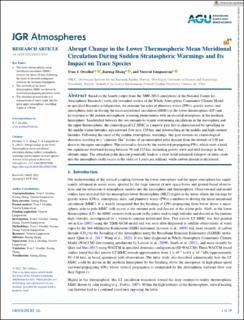| dc.contributor.author | Orsolini, Yvan J. | |
| dc.contributor.author | Zhang, Jiarong | |
| dc.contributor.author | Limpasuvan, Varavut | |
| dc.date.accessioned | 2022-10-31T13:01:18Z | |
| dc.date.available | 2022-10-31T13:01:18Z | |
| dc.date.created | 2022-10-26T12:25:03Z | |
| dc.date.issued | 2022 | |
| dc.identifier.citation | Journal of Geophysical Research. Atmospheres. 2022, 127, e2022JD037050. | en_US |
| dc.identifier.issn | 2169-897X | |
| dc.identifier.uri | https://hdl.handle.net/11250/3029146 | |
| dc.description.abstract | Based on the hourly output from the 2000–2014 simulations of the National Center for Atmospheric Research's vertically extended version of the Whole Atmosphere Community Climate Model in specified dynamics configuration, we examine the roles of planetary waves (PWs), gravity waves, and atmospheric tides in driving the mean meridional circulation (MMC) in the lower thermosphere (LT) and its response to the sudden stratospheric warming phenomenon with an elevated stratopause in the northern hemisphere. Sandwiched between the two summer-to-winter overturning circulations in the mesosphere and the upper thermosphere, the climatological LT MMC is a narrow gyre that is characterized by upwelling in the middle winter latitudes, equatorward flow near 120 km, and downwelling in the middle and high summer latitudes. Following the onset of the sudden stratospheric warmings, this gyre reverses its climatological direction, resulting in a “chimney-like” feature of un-interrupted polar descent from the altitude of 150 km down to the upper mesosphere. This reversal is driven by the westward-propagating PWs, which exert a brief but significant westward forcing between 70 and 125 km, exceeding gravity wave and tidal forcings in that altitude range. The attendant polar descent potentially leads to a short-lived enhanced transport of nitric oxide into the mesosphere (with excess in the order of 1 parts per million), while carbon dioxide is decreased. | en_US |
| dc.language.iso | eng | en_US |
| dc.rights | Navngivelse 4.0 Internasjonal | * |
| dc.rights.uri | http://creativecommons.org/licenses/by/4.0/deed.no | * |
| dc.title | Abrupt Change in the Lower Thermospheric Mean Meridional Circulation During Sudden Stratospheric Warmings and Its Impact on Trace Species | en_US |
| dc.title.alternative | Abrupt Change in the Lower Thermospheric Mean Meridional Circulation During Sudden Stratospheric Warmings and Its Impact on Trace Species | en_US |
| dc.type | Peer reviewed | en_US |
| dc.type | Journal article | en_US |
| dc.description.version | publishedVersion | en_US |
| dc.rights.holder | © 2022. The Authors. | en_US |
| dc.source.volume | 127 | en_US |
| dc.source.journal | Journal of Geophysical Research (JGR): Atmospheres | en_US |
| dc.identifier.doi | 10.1029/2022JD037050 | |
| dc.identifier.cristin | 2065228 | |
| dc.source.articlenumber | e2022JD037050 | en_US |
| cristin.ispublished | true | |
| cristin.fulltext | original | |
| cristin.qualitycode | 2 | |

